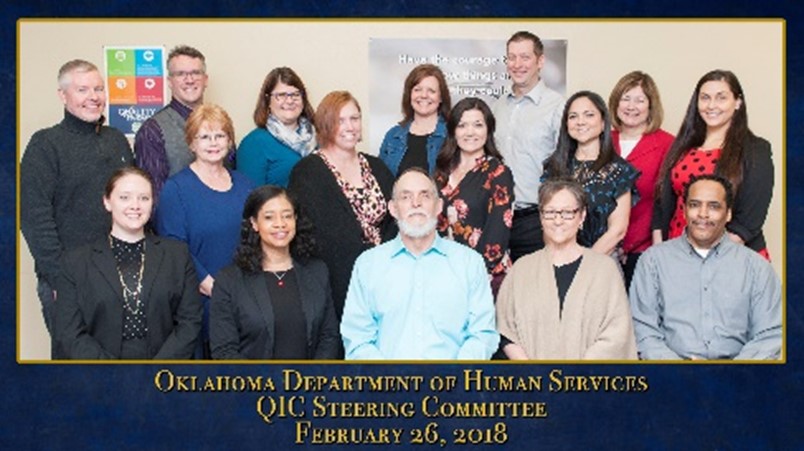Competency-based Personnel Selection
Oklahoma Department of Human Services (OKDHS) is a state-operated child welfare system, but hiring has always been done locally. The agency is divided into five field regions serving 27 districts and 77 counties. In 2017, OKDHS employed 1,780 Child Welfare Specialists (caseworkers) and 388 supervisors. That same year, the annual turnover rate was 25%. They applied to be a QIC-WD site with the goal of strengthening their child welfare workforce.
 When OKDHS started working with the Quality Improvement Center for Workforce Development (QIC-WD), a steering committee was established to participate in a needs assessment process, determine an intervention, and support implementation. The needs assessment took many months and included surveys and a review of Human Resources data. Hiring of new workers, promotion decisions for lead workers and supervisor positions, and staff recognition and rewards were identified as potential areas for intervention. The steering committee recognized that the criteria used for employee selection varied widely across the state and there was no standardized process from office to office. They expressed a need to better understand what characteristics were associated with good performance and how to hire people with those characteristics, and therefore decided to develop a competency-based personnel selection process. A theory of change was developed to explain how buy-in for and use of a standardized hiring process would improve worker retention and performance.
When OKDHS started working with the Quality Improvement Center for Workforce Development (QIC-WD), a steering committee was established to participate in a needs assessment process, determine an intervention, and support implementation. The needs assessment took many months and included surveys and a review of Human Resources data. Hiring of new workers, promotion decisions for lead workers and supervisor positions, and staff recognition and rewards were identified as potential areas for intervention. The steering committee recognized that the criteria used for employee selection varied widely across the state and there was no standardized process from office to office. They expressed a need to better understand what characteristics were associated with good performance and how to hire people with those characteristics, and therefore decided to develop a competency-based personnel selection process. A theory of change was developed to explain how buy-in for and use of a standardized hiring process would improve worker retention and performance.
 This video highlights the experience of staff and leaders who were involved in the new hiring process. |
The QIC-WD reviewed relevant research and best practices for employee selection. They conducted a job analysis and identified 24 important competencies for the Child Welfare Specialist job through a series of behavioral event interviews and surveys. The QIC-WD team developed ways to assess whether a job candidate possessed these competencies. The standardized hiring process ultimately included a structured interview, a typing test, and a writing assessment. A behaviorally anchored rubric was used to facilitate reliable ratings of the competencies.
 The QIC-WD began to train potential hiring panel members and Administrative Assistants to implement the standardized personnel selection process in 2020. To provide flexibility and meet agency needs, in-person and virtual interview processes were developed. In addition, all hiring materials and processes were paperless. Two resources were developed to support implementation—a step-by-step guide to assist the Administrative Assistants with their administrative tasks in the process and a rating guide for hiring panels to use during the interview. Training was ongoing and refresher trainings were offered to support implementation.
The QIC-WD began to train potential hiring panel members and Administrative Assistants to implement the standardized personnel selection process in 2020. To provide flexibility and meet agency needs, in-person and virtual interview processes were developed. In addition, all hiring materials and processes were paperless. Two resources were developed to support implementation—a step-by-step guide to assist the Administrative Assistants with their administrative tasks in the process and a rating guide for hiring panels to use during the interview. Training was ongoing and refresher trainings were offered to support implementation.
 A randomized control trial design was used to test the intervention and key findings also include implementation learnings. Between October 2020 and February 2022, 716 interviews were conducted using the standardized hiring protocol, with most (69%) led by a two-person hiring panel. Reactions to the process were more positive among those hired via the competency-based selection process; specifically, they were more likely to be satisfied with their experience and to agree that it provided an opportunity to show their capabilities, provided valuable information about the job, and was conducted fairly.
A randomized control trial design was used to test the intervention and key findings also include implementation learnings. Between October 2020 and February 2022, 716 interviews were conducted using the standardized hiring protocol, with most (69%) led by a two-person hiring panel. Reactions to the process were more positive among those hired via the competency-based selection process; specifically, they were more likely to be satisfied with their experience and to agree that it provided an opportunity to show their capabilities, provided valuable information about the job, and was conducted fairly.  After six months in the job, candidates hired using the competency-based selection process reported higher work engagement than those hired with the usual process, but similar levels of self-efficacy, perceived fit, job satisfaction, organizational commitment, and intentions to stay. Nonetheless, those who were hired using the new process were more likely to stay in the job during the study period; specifically, the hiring process lowered the risk of leaving by 22%. Those who chose to leave the agency, however, did so more quickly than those who were hired using the old process. Finally, performance ratings from supervisors at six months after hire did not differ based on which selection process was used, but within the group hired using the new process, higher scores on the selection tools were associated with better performance. Those who scored above certain levels were as much as 5.5 times as likely to have higher than average performance than those below those levels.
After six months in the job, candidates hired using the competency-based selection process reported higher work engagement than those hired with the usual process, but similar levels of self-efficacy, perceived fit, job satisfaction, organizational commitment, and intentions to stay. Nonetheless, those who were hired using the new process were more likely to stay in the job during the study period; specifically, the hiring process lowered the risk of leaving by 22%. Those who chose to leave the agency, however, did so more quickly than those who were hired using the old process. Finally, performance ratings from supervisors at six months after hire did not differ based on which selection process was used, but within the group hired using the new process, higher scores on the selection tools were associated with better performance. Those who scored above certain levels were as much as 5.5 times as likely to have higher than average performance than those below those levels.
OKDHS has strong evidence to support the expanded use of the standardized hiring process. The agency is implementing a streamlined version of the competency-based selection process statewide.
All OKDHS resources summarized here can be found on the QIC-WD website.